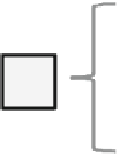Graphics Reference
In-Depth Information
y-axis:
number of samples in band
x-axis:
sample intensity
first band position
signal four offsets from
the first band
Fig. 7.17
Example of sample distribution in a CTB, where BO sends the offsets of four
consecutive bands. Reproduced with permission from [
13
], © 2012 IEEE
Merge
Up
Luma
CTB
Merge
Left
Current
CTU
Cb
CTB
CTU
Cr
CTB
Fig. 7.18
CTU consists of three CTBs of color components; the current CTU can reuse SAO
parameters of the left or above CTU. Reproduced with permission from [
13
], © 2012 IEEE
7.3.4
SAO Parameters Signaling
A syntax element
sample_adaptive_offset_enabled_flag
signaled
in the Sequence Parameter Set (SPS) indicates whether SAO is enabled
in the current video sequence. In the slice header, two syntax elements,
slice_sao_luma_flag
and
slice_sao_chroma_flag
, indicate if SAO
is enabled for luma and chroma, respectively, in the current slice.
Low-delay applications can use the Coding Tree Unit (CTU) based SAO
encoding algorithm. As shown in Fig.
7.18
, a CTU comprises its corresponding
luma CTB, Cb CTB, and Cr CTB. Syntax-wise, the basic unit for SAO parameters
adaptation is always one CTU. If SAO is enabled in the current slice, the SAO
parameters of each CTU are interleaved into the slice data. The SAO data in
the bitstream are signaled in the beginning of each CTU. The CTU-level SAO
parameters consist of SAO merging information, type information, and offset
information.
7.3.4.1
SAO Parameters Merging
A CTU can use three options for signaling SAO parameters: reusing SAO param-
eters of the left CTU (by setting a syntax element
sao_merge_left_flag






















